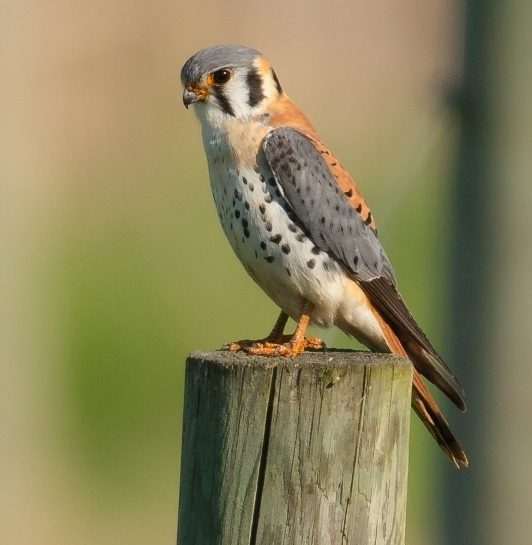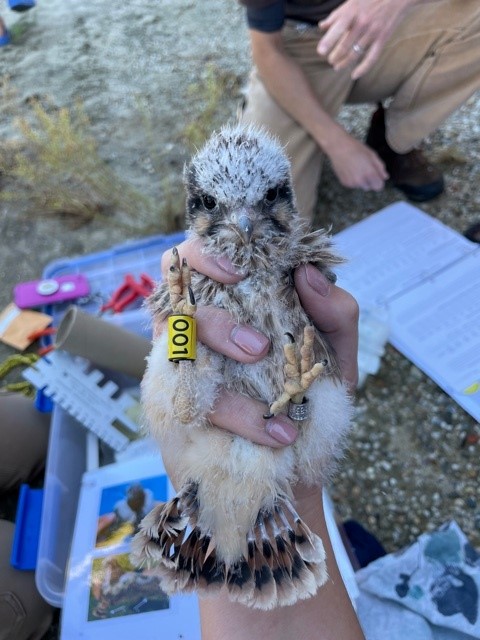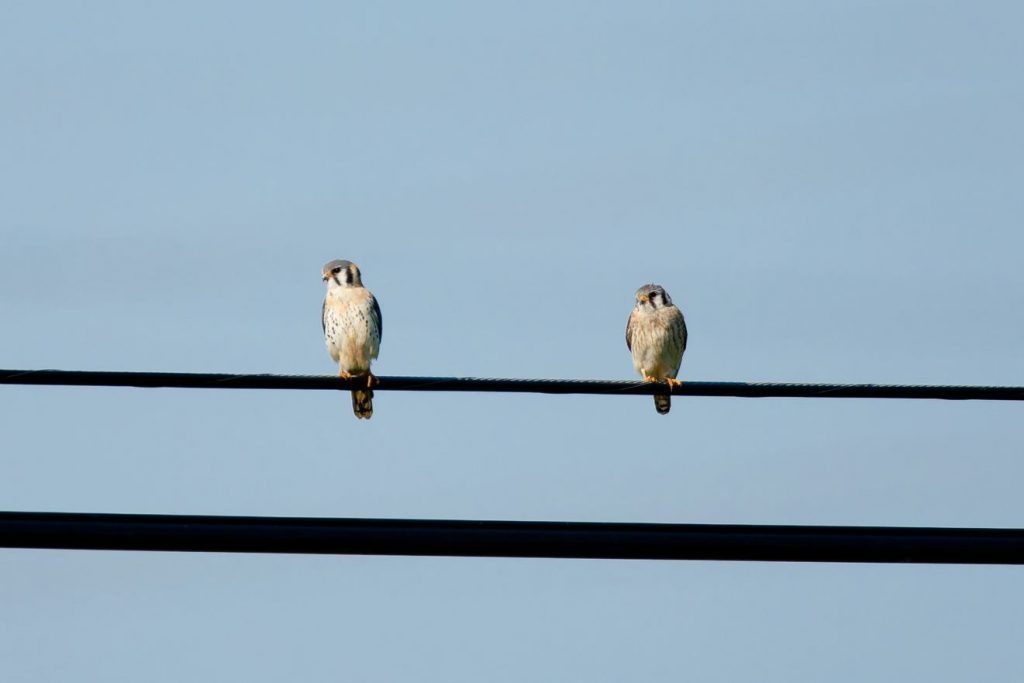American kestrel populations in Delaware have declined. Once commonly seen perched along telephone wires and fence posts, this falcon is now a rare sight across our state. The DNREC Division of Fish and Wildlife works to study and manage the state’s population of American kestrels.
Jordan Brown
Raptor, Grassland and Forest Bird Biologist
302-255-1960
According to the USGS Breeding Bird Survey, populations of American kestrels have declined more than 93% in the Mid-Atlantic region over the last 50 years. These declines are what led DNREC to list the American kestrel as state endangered in 2013 and as a Tier 1 Species of Greatest Conservation Need in the 2015 Delaware Wildlife Action Plan.
The DNREC Division of Fish and Wildlife and its partners in the Delaware Kestrel Partnership are working to study this raptor and find ways to reverse that decline. They offer volunteer opportunities for citizen scientists.
Read more about the American kestrel, and the Partnership, in a story in Outdoor Delaware.

American kestrels are found across North and South America. They prefer open habitats such as meadows, grasslands, open parkland, agricultural fields and even deserts. These habitats usually feature short ground vegetation with sparse woody vegetation, trees with cavities to nest in and plenty of perches.
Kestrels primarily eat small rodents (voles and mice) and insects (grasshoppers, cicadas, dragonflies and spiders). Occasionally, they also eat bats, small birds, snakes and lizards.
American kestrels are often seen hunting from a perch in a “sit-and-wait” fashion or hovering over prey in a field before striking.
American kestrels are obligate secondary cavity nesters, meaning they must use natural cavities or those created by woodpeckers to nest. They prefer cavities that do not have vegetation or branches covering the hole. Kestrels will not use nesting material and instead create a scrape or depression in the cavity floor.
In 2016, the DNREC Division of Fish and Wildlife joined Delaware State Parks’ Brandywine Zoo to create what is now the Delaware Kestrel Partnership. The Partnership was created to study North America’s smallest falcon, the American kestrel, to investigate their declining population.
To understand more about Delaware’s kestrel population, nest box monitoring and kestrel banding programs were created to gather long-term data on breeding kestrels.
The Delaware Kestrel Partnership has installed more than 70 nest boxes on public and private lands — in open areas such as meadows, grasslands, pastures and other agricultural fields.
The nest boxes are installed on 4×4 poles or on existing structures such as fencerows or barns. Ideally, kestrel nest boxes are not within 50 yards of a tree line, to reduce predator access, but are within 100 yards of perching opportunities such as power lines, fencerows and snags (dead trees).
The Partnership thanks all the landowners who allow use of their property for this research. A few of the largest landowner partners include Delaware State Parks, The Delaware Nature Society, Delaware Wild Lands, Mount Cuba Center, The University of Delaware and Winterthur Museum, Garden and Library.
If you are interested in building a nest box for the program, hosting a nest box on your property, or if you know of a location that may provide good habitat, please contact Jordan.Brown@delaware.gov.

Biologists and other researchers sometimes outfit birds with unique markers to help identify individuals and track their movements.
Since the start of the Partnership, researchers have put USGS aluminum leg bands on adult kestrels and their chicks. However, these bands are small and difficult to read from far away.
As of 2021, the Partnership has begun applying colored bands on kestrels, making them easier to read and making it easier to identify individuals. These bands are bright yellow with black letters and have a three-digit number on them (e.g. “001” or “025”).
If you see this band (likely through binoculars, spotting scope, or camera) please report it to the USGS Banding Bird Lab. The lab creates sighting reports for the state.
In 2024, the Delaware Kestrel Partnership monitored 81 nest boxes across the state from March through July. Volunteers observed American kestrels at 20 of these nest boxes and breeding pairs at 14. A total of 40 eggs were laid, producing only 21 chicks.
Two nests failed – one was abandoned by the nesting pair for an unknown reason and the other was predated. The nesting pair that experienced predation attempted to re-nest but were once again unsuccessful.
The other five nest boxes each had at least one unhatched egg. These eggs were collected and will eventually be tested to see if there was a reason they were unsuccessful.
A total of nine adult birds were captured for banding; however, five of those individuals were re-captured, meaning they already had bands on their legs. These individuals were from New Jersey (2), Pennsylvania, Virginia, and Delaware originally.
A total of 11 chicks were banded in 2024 – a much lower number than usual. Not only did the nests experience a higher rate of failure, but the chicks were hatching much later than usual. Late hatching (and therefore higher temperatures) resulted in many chicks leaving the nest earlier than anticipated. As a result, they were missed by DNREC staff.

New for 2024, staff placed Motus radio tags on 14 American kestrel adults and nestlings as part of a new study, tracking the movements of these birds year-round.
The tags rely on compatible receiving towers sending signals back to the researcher. As of February 2025, Delaware has 14 towers and would like to install at least four more, using grant funding provided by the U.S. Fish & Wildlife Service’s Wildlife Restoration Program.
You can keep tabs on where these, and future, tagged birds, have been using the Motus Wildlife Tracking System.
In 2023, the Partnership monitored 75 nest boxes and found American kestrels at 21, with breeding pairs at eight. There were 34 eggs in 2023, producing 33 chicks.
In 2022, the Partnership monitored 69 nest boxes and found American kestrels at 19, with breeding pairs at ten. There were 35 eggs in 2022, producing 27 chicks.
Reporting sightings of American kestrels helps state biologists select better locations to install nest boxes for breeding birds.

Kestrels are often found perched on utility wires and fencerows where they have a better view to hunt. Look for their signature “bobbing tail” while they stabilize themselves on their perch.
If you see a kestrel, please log your sightings at eBird.org and include as many details as you can (sex, location, behavior, etc.) from your observations.
You can report both USGS aluminum leg bands and colored bands to the Banding Bird Lab.
To read an aluminum USGS band, you will need to physically have the bird in hand. If you find a dead kestrel with a leg band, please make every effort to report it. If you find an injured kestrel, please call Tri-State Bird Rescue at 302-737-9543. They will report the band.
To report a color band, select “Color Marker Only” on the Banding Bird Lab site and answer the questions on that site.
The colored bands on Delaware birds are placed on the bird’s right leg with a yellow marker. The color code is black. Please also enter the number.
You can host a Motus tower and help researchers track the migration of Kestrels and other species.
Delaware plans to fund four more towers near the following locations: Glasgow, Townsend, Kenton, Seaford, Laurel, Delmar, Millsboro or Long Neck.
If you have an open field without tree cover, a building (or roof) that a tower can attach to, or even an existing tower where antenna can be placed, please contact Jordan.Brown@delaware.gov.
Related Topics: American kestrels, conservation, fish and wildlife, raptors, wildlife